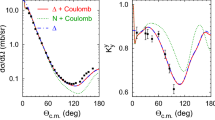Abstract
A discussion about the classical Coulomb repulsion via point-like nuclear charges, usually employed within Born–Oppenheimer approximation, leads to the description of Dirac paradox: an inconsistency found when describing nuclear charges by means of Dirac’s distributions and computing with them nuclear Coulomb repulsion integrals. The way of overcoming Dirac paradox is bound to the description of soft Gaussian nuclear charge density and also to adopting a nuclear hypermultiplet Coulomb repulsion formulation. Such theoretical prospect produces a quantum mechanically compliant but simple algorithm in order to compute nuclear repulsion, which also appears to be consistently related to classical Coulomb repulsion energy, while avoiding singularities when nuclei collapse.
Similar content being viewed by others
References
M. Born, R. Oppenheimer, Ann. Phys. 84, 457–484 (1927)
D. Andrae, Phys. Rep. 336, 413–525 (2000)
E. Besalú, R. Carbó-Dorca, J. Math. Chem. 49, 2231–2243 (2011)
R. Carbó-Dorca, J. Math. Chem. 51, 1092–1098 (2013)
Ll Amat, R. Carbó-Dorca, J. Comput. Chem 18, 2023–2029 (1997)
Ll Amat, R. Carbó-Dorca, J. Comput. Chem. 20, 911–920 (1999)
Ll Amat, R. Carbó-Dorca, J. Chem. Inf. Comput. Chem. Sci 40, 1188–1198 (2000)
E. Besalú, R. Carbó-Dorca, J. Mol. Graph. Mod. 39, 39–49 (2013)
E. Besalú, R. Carbó-Dorca, J. Math. Chem. 51, 1771–1783 (2013)
R. Carbó-Dorca, Indian J. Chem. 53A, 1043–1051 (2014)
H. Weinstein, P. Politzer, S. Srebrenik, Theor. Chim. Acta 38, 159–163 (1975)
V.R. Saunders, in Computational Techniques in Quantum Chemistry and Molecular Physics, ed. by G.H.F. Diercksen, B.T. Sutcliffe, A. Veillard (D. Reidel Pub. Co., Dordrecht (Holland), 1975)
M. Abramowitz, I.A. Stegun, Handbook of Mathematical Functions (Dover Pub. Inc., New York, 1972)
R. Carbó, L. Domingo, J. Gregori, Int. J. Quant. Chem. 17, 725–736 (1980)
W. Heisenberg, Zeits. Phys. 49, 619–636 (1928)
C.C.J. Roothaan, Rev. Mod. Phys. 23, 69–89 (1951)
J. Arents, Chem. Phys. Lett. 12, 489–492 (1972)
P.W. Ayers, Theor. Chem. Acc. 115, 253–256 (2006)
P.W. Ayers, R.G. Parr, J. Am. Chem. Soc. 123, 2007–2017 (2001)
J.S.M. Anderson, J. Melin, P.W. Ayers, J. Chem. Theory Comput. 3, 358–374 (2007)
Author information
Authors and Affiliations
Corresponding author
Appendix
Appendix
1.1 Incomplete gamma function
A set of polynomial expressions to accurately compute the incomplete gamma functions needed here was published by Arents [17]. Also, knowing any higher order term, then a unit order inferior function can be easily obtained by means of the descending iteration [11]:
Then, one can also write:
1.2 Derivatives
Derivatives of the incomplete gamma function and error function are not at all difficult to obtain. They can be useful for general geometry optimization purposes.
1.2.1 A of the incomplete gamma function
The derivatives of the incomplete gamma function of any order can be expressed [12] in terms of the incomplete gamma function of a unit superior order:
1.2.2 B of the error function
Derivatives of the error function are readily computed in terms of Hermite polynomials [13]:
Thus, the first derivative term, owing to the fact that also: \(H_0 \left( x \right) =1\) holds, corresponds to:
Rights and permissions
About this article
Cite this article
Carbó-Dorca, R. Coulomb repulsion, point-like nuclear charges, Dirac paradox, soft nuclear charge density and hypermultiplet nuclear repulsion. J Math Chem 53, 590–603 (2015). https://doi.org/10.1007/s10910-014-0436-8
Received:
Accepted:
Published:
Issue Date:
DOI: https://doi.org/10.1007/s10910-014-0436-8



